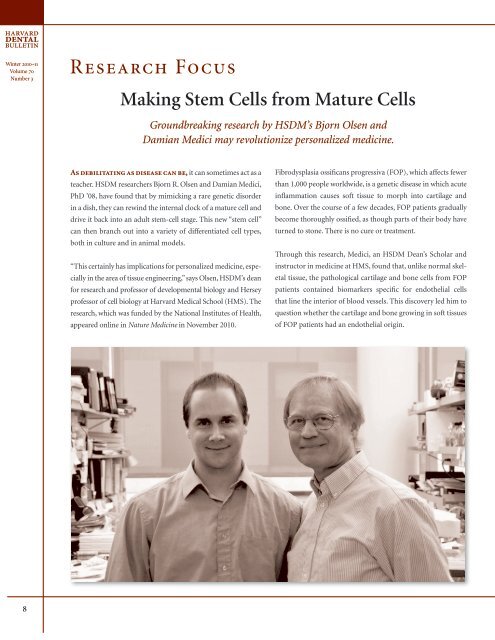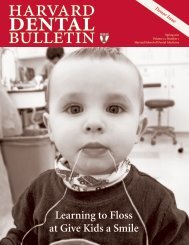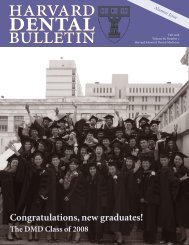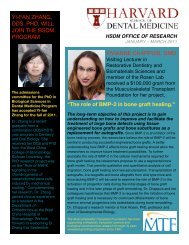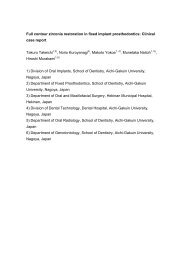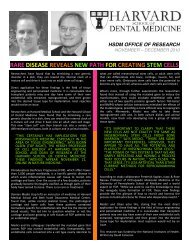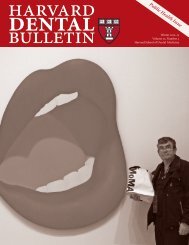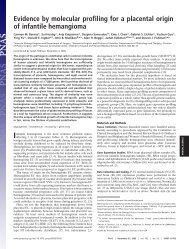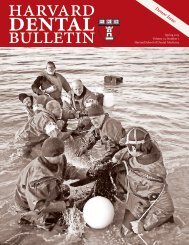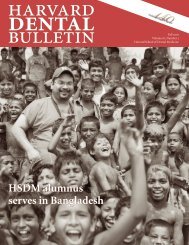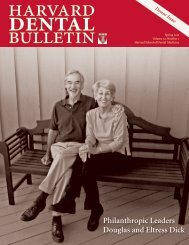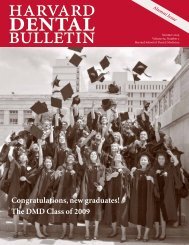harvarddentalbulletinWinter 2010–11Volume 70Number 3<strong>Research</strong> FocusMaking Stem Cells from Mature CellsGroundbreaking research by HSDM’s Bjorn Olsen andDamian Medici may revolutionize personalized medicine.As debilitating as disease can be, it can sometimes act as ateacher. HSDM researchers Bjorn R. Olsen and Damian Medici,PhD ’08, have found that by mimicking a rare genetic disorderin a dish, they can rewind the internal clock <strong>of</strong> a mature cell anddrive it back into an adult stem-cell stage. This new “stem cell”can then branch out into a variety <strong>of</strong> differentiated cell types,both in culture and in animal models.“This certainly has implications for personalized medicine, especiallyin the area <strong>of</strong> tissue engineering,” says Olsen, HSDM’s deanfor research and pr<strong>of</strong>essor <strong>of</strong> developmental biology and Herseypr<strong>of</strong>essor <strong>of</strong> cell biology at <strong>Harvard</strong> Medical <strong>School</strong> (HMS). Theresearch, which was funded by the National Institutes <strong>of</strong> Health,appeared online in Nature <strong>Medicine</strong> in November 2010.Fibrodysplasia ossificans progressiva (FOP), which affects fewerthan 1,000 people worldwide, is a genetic disease in which acuteinflammation causes s<strong>of</strong>t tissue to morph into cartilage andbone. Over the course <strong>of</strong> a few decades, FOP patients graduallybecome thoroughly ossified, as though parts <strong>of</strong> their body haveturned to stone. There is no cure or treatment.Through this research, Medici, an HSDM Dean’s Scholar andinstructor in medicine at HMS, found that, unlike normal skeletaltissue, the pathological cartilage and bone cells from FOPpatients contained biomarkers specific for endothelial cellsthat line the interior <strong>of</strong> blood vessels. This discovery led him toquestion whether the cartilage and bone growing in s<strong>of</strong>t tissues<strong>of</strong> FOP patients had an endothelial origin.8
esearch fo cusMedici and his colleagues transferred the mutated gene thatcauses FOP into normal endothelial cells. Unexpectedly, theyfound that the endothelial cells converted into a cell typenearly identical to mesenchymal stem cells, or adult stem cellsthat can differentiate into bone, cartilage, muscle, fat, andeven nerve cells. (Embryonic stem cells have the potential tobecome any type <strong>of</strong> cell, whereas adult stem cells are limited.)What’s more, through further experiments, the researchersfound that instead <strong>of</strong> using the mutated gene to induce thetransformation, they could incubate endothelial cells witheither one <strong>of</strong> two specific proteins (growth factors TGF-beta2and BMP4) whose cellular interactions mimicked the effects <strong>of</strong>the mutated gene, providing a more efficient way to reprogramthe cells. Medici was then able to take these reprogrammedcells and, in both culture dishes and animal models, coax theminto developing into a group <strong>of</strong> related tissue types.“It’s important to clarify that these new cells are not exactlythe same as mesenchymal stem cells from bone marrow,” saysMedici. “There are some important differences. However, theyappear to have all the potential and plasticity <strong>of</strong> mesenchymalstem cells.”Olsen elaborates. “The power <strong>of</strong> this system is that we are simplyrepeating and honing a process that occurs in nature,” hesays. “In that sense, it’s less artificial than other current methodsfor reprogramming cells.”According to study collaborator Frederick Kaplan, Isaac & RoseNassau pr<strong>of</strong>essor <strong>of</strong> orthopaedic molecular medicine at theUniversity <strong>of</strong> Pennsylvania <strong>School</strong> <strong>of</strong> <strong>Medicine</strong> and a worldrenownedexpert on FOP, “While we want to use this knowledgeto stop the renegade bone formation <strong>of</strong> FOP, these new findingsprovide the first glimpse <strong>of</strong> how to recruit and harness theprocess to build extra bone for those who desperately need it.”Medici and Olsen agree that the most direct application forthese findings is in the field <strong>of</strong> tissue engineering and personalizedmedicine. It is conceivable that transplant patients mightone day have some <strong>of</strong> their own endothelial cells extracted,reprogrammed, and then grown into the desired tissue type forimplantation—eliminating the problem <strong>of</strong> host rejection.Adapted with permission from an article by David Cameron,Office <strong>of</strong> Communications and External Relations, HMS.The image on the left is <strong>of</strong> normal endothelial cells. Theimage on the right is <strong>of</strong> endothelial cells that have beenconverted into mesenchymal stem cells.Opposite: <strong>Research</strong> on a rare disease by HSDM Dean’s Scholar Damian Medici(left) and Dean for <strong>Research</strong> and Pr<strong>of</strong>essor <strong>of</strong> Developmental Biology BjornR. Olsen led to unexpected results that hold great promise for patients wellbeyond those who suffer from that disease.9


